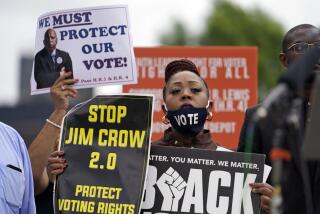Judging the Voting Rights Act
- Share via
Rightly regarded as one of the most lustrous legacies of the civil rights movement, the Voting Rights Act of 1965 outlaws discrimination in voting nationwide, but it also requires that states with a history of denying minorities the right to vote obtain the approval of a federal court or the U.S. Justice Department before changing election procedures. This “preclearance” provision, contained in Section 5 of the act, has been repeatedly reauthorized by Congress — most recently in 2006, when it was extended for another 25 years by margins of 390 to 33 in the House and 98 to 0 in the Senate.
Between 1982 and 2006, the Justice Department used the preclearance process to block the enforcement of more than 2,400 voting changes on the grounds that they would undermine minority voting rights. Yet this proven protection may be on constitutional life support. On Wednesday, the Supreme Court will hear arguments in a case from Alabama that challenges Section 5 and the formula by which nine states, mostly in the South, and parts of seven others (including California) are required to obtain preclearance when they redraw district lines, modify registration procedures or change any other practice that might disadvantage minority voters. Supporters of the Voting Rights Act fear that conservative members of the court — and perhaps not only conservatives — are poised to rule that the law violates the prerogatives of states that no longer practice the sort of blatant discrimination that inspired the original legislation.
That would be a mistake of historic proportions. It may no longer be true that African Americans registering to vote are required to face down hostile election officials or endure literacy tests, or that city councils and legislatures in the South are all-white and determined to remain so. But subtler forms of discrimination against blacks and other minorities persist — such as gerrymandering to dilute their voting power or relocating polling stations to make them less accessible to minorities — and Congress has reasonably determined that they are more of a problem in some places than in others. The court should respect that judgment.
Critics complain that preclearance unfairly punishes parts of the country that long ago changed their ways and that, while the law allows for jurisdictions to “bail out” of preclearance, the process is overly onerous. They also complain of a double standard: When Texas wanted to impose a photo ID requirement on voters, it had to seek federal approval (which was denied); Pennsylvania was able to enact photo ID legislation without such an encumbrance.
Members of the Supreme Court apparently share those concerns. Four years ago, the court said that the law’s preclearance provision raises “serious constitutional questions.” “Things have changed in the South,” Chief Justice John G. Roberts Jr. wrote. “Voter turnout and registration rates now approach parity. Blatantly discriminatory evasions of federal decrees are rare. And minority candidates hold office at unprecedented levels.” In light of that progress, Roberts raised the question of whether preclearance was still a justifiable infringement of the “equal sovereignty” of the states. Seven other justices signed Roberts’ opinion. Justice Clarence Thomas went further and declared flatly that Section 5 was unconstitutional.
The Roberts opinion was widely interpreted as a hint to Congress that it should revisit Section 5 and fine-tune the Voting Rights Act’s coverage formula, which reflects decades-old statistics on minority voter turnout in covered jurisdictions. In the absence of such action, a majority of the court may be tempted to strike down the law, forcing Congress to undertake a new and more searching inquiry into the incidence of voting discrimination — a start-from-scratch process that supporters of voting rights fear would never get very far.
The court should resist that temptation. In the course of the 22 hearings it held before extending Section 5 in 2006, Congress adduced significant evidence of discriminatory practices in the covered jurisdictions, and reasonably concluded that problems were more common in those states and municipalities than elsewhere. Admittedly, as a federal appeals court noted in upholding the law, “the coverage formula’s fit is not perfect. But the fit was hardly perfect in 1965.” Nevertheless, the law was upheld by the Supreme Court.
Judicial second-guessing of Congress is especially inappropriate in the voting rights context. The Constitution explicitly empowers Congress to “enforce … by appropriate legislation” the 15th Amendment’s guarantee that the right to vote “shall not be denied or abridged by the United States or by any state on account of race, color, or previous condition of servitude,” as well as the 14th Amendment’s guarantee of “equal protection of the laws.” In extending Section 5 of the Voting Rights Act, Congress exercised its authority by huge majorities — majorities that included representatives and senators from states subject to preclearance. There is no reason for the court to substitute its own judgment about how best to secure voting rights in the 21st century.
More to Read
A cure for the common opinion
Get thought-provoking perspectives with our weekly newsletter.
You may occasionally receive promotional content from the Los Angeles Times.









